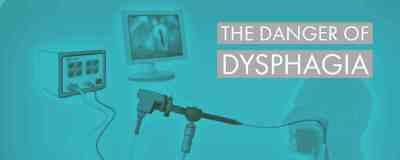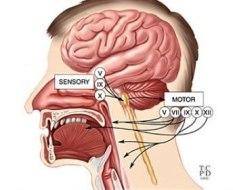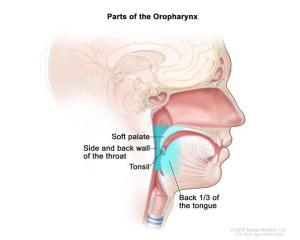
Most of us never consider the physical mechanics involved with eating or drinking. Open, chew, swallow, repeat. It turns out swallowing is a complicated process which demands a perfectly coordinated effort between your brain, nerves and muscle system (If you have superficial siderosis your inner alarm bell should be blasting).
The term Dysphagia covers all swallowing problems but includes two groups. The first type involves a physical or structural problem in your body which impairs movement. The second type, which affects those with neurodegeneration, stem from issues with your neural and motor control center. Malfunctioning nerves responsible for the progressive worsening of dysphagia present a genuine danger to your well being.

V — Trigeminal Sensory and motor fibers of the face important in chewing VII — Facial Sensory and motor fibers important for oropharynx & taste/sensation to front 2/3 of tongue IX — Glossopharyngeal Sensory and motor fibers Taste/sensation to rear tongue, pharynx sensory and motor function X — Vagus Sensory and motor fibers for taste to oropharynx, sensation and motor function to larynx and laryngopharynx. important for airway protection XII — Hypoglossal Motor fibers of the tongue
Staying Aware
Gary paid a visit to the speech-swallow clinic during our last trip to Little Rock for a Fiberoptic Endoscopic Evaluation of Swallowing (FEES). He occasionally has episodes of coughing or choking with both liquids and solids, a 15-year history of GERD, suffers annual bouts of pneumonia, and one episode of pleurisy with pulmonary infiltrates.
Given his diagnosis of superficial siderosis his neurology team felt it was time to get a baseline test so the speech-language pathology clinic could follow his case in the event symptoms progress. A FEES evaluation only provides information on the oral and pharyngeal phases. To evaluate esophageal problems a different type of test is needed.
Gary’s speech-language pathologist applied lidocaine with a swab to the inside of one nostril. The endoscope tube was lubricated and passed through his nose and nasal cavity.
A monitor displayed the results of several swallow tests. The first was drinking milk. Next, he swallowed applesauce tinted with blue dye. He then chewed and swallowed a cookie and finished up with a cookie and milk combination. Liquid, puree, and solids.
The Mechanics Of Swallowing
There are three distinct (oral, pharyngeal, and esophageal) phases involved with moving your food from your mouth to your stomach. A specific set of motor and cranial sensory nerves controls each step.

Oral
When you finish chewing the nerves that control the muscles of your tongue and throat will begin to move everything to the upper back part of your throat (oropharynx). Next, as your soft palate elevates to block anything from entering your nose, your tongue and pharyngeal muscles continue to move food into the lower pharynx (throat).
Pharyngeal
When food reaches the pharynx, your sensory nerves take control of the involuntary phase of swallowing. The swallowing reflex automatically moves everything towards your esophagus. The most critical malfunction during this phase is if your epiglottis doesn’t move to block your larynx off. We’re all familiar with something going down the “wrong pipe” if we accidentally take a breath during a swallow.
Esophageal
Food or liquids move into the esophagus and continue toward the stomach from a combination of muscle contractions and two esophagus sphincter muscles. The upper sphincter closes to stop food from going back up into your mouth. The lower sphincter closes to prevent food from leaving the stomach.
Signs Of Trouble Ahead
Early symptoms may be highly variable and unpredictable as nerve degeneration and motility problems progress. Gary has been diagnosed to be in early stage. His primary concern, for now, seems to be with the mechanics of coordinating the muscles of his tongue and mouth into a swallow.
Symptoms you should be aware of include:
- Difficulty in moving food to the rear of the throat
- Feeling that food is stuck
- Coughing or choking when swallowing
- Drooling
- Solids or liquid backing up through the nose
It’s critical your epiglottis protects your lungs from particles of food or liquids; if particles infiltrate the lungs, tissue irritation can lead to severe infection. Lung infections caused by problems with your swallowing reflex are known as aspiration pneumonia.
Swallow Strategies
The speech-language pathologist gave us a list of “Swallow Strategies” to help avoid problems while eating.
- Add sauces or gravy to solid foods
- Cut food into small bite-sized pieces
- Always sit up when eating and drinking
- Take small bites or sips, one at a time and swallow
- Eat very slowly
- Take a sip of liquid after every bite of solids
- Place medications into applesauce, yogurt or pudding
- Remain sitting upright for 30 minutes after eating
Gary is scheduled to return to the speech-swallow clinic in six months for a follow-up and an updated FEES evaluation test.

